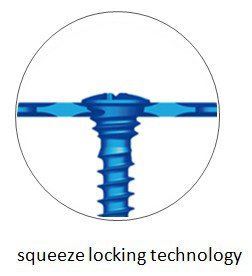Material: medical pure titanium
Thickness: 1.0mm
Product specification
|
Item No. |
Specification |
|
|
10.01.04.08023000 |
8 holes |
25mm |
|
10.01.04.12023000 |
12 holes |
38mm |
|
10.01.04.16023000 |
16 holes |
51mm |
Features & Benefits:

• locking maxillofacial micro and mini plate can be used reversibly
• locking mechanism: squeeze locking technology
• one hole select two kinds of screw: locking and non-locking are all available, probabilize the free collocation of plates and screws, meet the demand of clinical indications better and more extensive indication
• bone plate adopt special customized German ZAPP pure titanium as raw material, with good biocompatibilty and more uniform grain size distribution.Don't affect MRI/CT examination
• bone plate's edge is smooth, reduce the stimulation to soft tissue.
Matching screw:
φ2.0mm self-drilling screw
φ2.0mm self-tapping screw
φ2.0mm locking screw
Matching instrument:
medical drill bit φ1.6*12*48mm
cross head screw driver: SW0.5*2.8*95mm
straight quick coupling handle

Locking plate is a fracture fixation device with a locking threaded hole.The locking plate allows the bone to bond more firmly to the plate, making the amputated limb more stable after repositioning.
Lock plates were first used 20 years ago in spine and maxillofacial surgery to stabilize fractures while reducing extensive soft tissue dissection and injury.
A locking plate is a fracture fixation device with threaded holes in which the plate acts as an Angle fixation device when a screw with a threaded head is inserted.Both locking and non-locking holes can be provided for different screw insertion.Any plate that can be screwed into a fixed (stable) Angle screw or bolt is essentially a locking plate.The fixation of the steel plate does not depend on the bone friction to realize the connection, but entirely depends on the locking structure of the steel plate itself.A certain gap can be left between the steel plate and the bone surface, which eliminates the adverse effect of the heavy contact between the steel plate and the bone, and greatly improves the blood supply and the growth and recovery of periosteum.The main biomechanical difference between traditional steel plate and traditional steel plate is that the latter relies on the friction force at the bone-plate interface to compress the bone.
The locking screw is self-tapping screw and can be used without tapping or bone drill.There is no pressure between the steel plate and the bone cortex, so there is no pressure on the periosteum, so as to protect the blood supply of periosteum.In terms of surgical technique, it can meet the requirements of minimally invasive operation, and can well protect the local blood supply of the fracture, so that bone grafting operation is not needed.The internal fixation scaffold is elastic. In the presence of load, there is stress stimulation between the fracture blocks, which is conducive to callus formation and fracture healing.
After maxillofacial fracture, it is mainly reduction and fixation.The important sign of jaw fracture reduction is to restore the normal occlusal relationship of upper and lower teeth, that is, the extensive contact relationship of teeth.Otherwise it will affect the recovery of mastication function after fracture healing.There are three common reset methods:
1.Manipulative reduction: in the early stage of jaw fracture, the fracture segment is relatively active, and the displaced fracture segment can be returned to the normal position by hand.
2.Traction reduction: after the fracture of the jaw, after a long time (more than three weeks of the maxilla, more than four weeks of the mandible), the fracture has part of the fibrous tissue healing, manual reduction is not successful, traction reduction method can be used.The mandibular fracture multi-purpose jaw traction, is in the mandibular bone has the displacement of the fracture section of the placement of subsection dental arch splint, and then between the dental arch splint and the maxillary, with a small rubber band for elastic traction, so that it gradually restore the normal occlusal relationship.After maxillary fracture, if the fracture segment shifts backwards, the dental arch splint can be placed on the maxillary dentition, and a plaster cap with a metal bracket can be made on the head. The elastic traction can be made between the dental arch splint and the metal bracket, so that the maxillary fracture segment can be restored forward.Horizontal gravity traction can also be used when large traction force is needed.
3.Open reduction: The indications for open reduction are broad.Open reduction should be performed when the fracture segment is displaced for a long time and there is fibrous healing or bony malalignment healing, and the reduction cannot be achieved by manipulation or traction.The fibrous tissue formed in the dislocation healing between the broken ends of the fracture is excised or the callus is chiseled away, and the jaw is re-dissected to return to its normal position.Open reduction is usually used for fresh fractures or open fractures with difficulty in manual reduction or instability after reduction.









